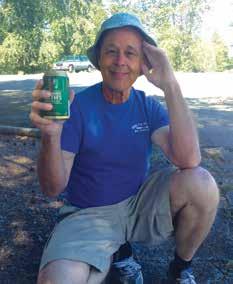
6 minute read
Some Reflections on the Creation of the “MA-ALS” Program at SFU
Robert M. Gordon, PhD
At the time of writing, March 2021, more than 50 per cent of practising Notaries in British Columbia are graduates of SFU’s MA in Applied Legal Studies (MA-ALS) Program.
For those closely associated with the Program, that statistic is immensely gratifying especially since both the development and the implementation of a professional graduate program like MA-ALS involves a range of significant challenges.
They include securing the initial approval and then the actual support (fiscal and otherwise) of the upper echelons of the affected university (including the university senate); identifying and hiring qualified, committed, and energetic faculty and staff; recruiting and retaining qualified prospective graduate students; and generating and maintaining the support of the affected professional bodies. The list is not exhaustive.
There is little doubt that teamwork lies at the heart of a successful professional graduate program and that was a key characteristic of the MA-ALS partnership from its inception.
From the early 2000s onward, numerous conversations took place at various locations (some more informal than others), focused on the best ways of meeting the objectives of both The Society of Notaries Public and the University. It wasn’t always a match made in heaven but, in the end, the process and the outcome reflected a happy and productive union. There were, in essence, two teams of people involved with the MA-ALS project—one led by Wayne Braid, then
©iStockphoto.com/Brendan Hunter
Executive Director of The Society of Notaries Public, and the other led by me, a Professor in the School of Criminology at SFU and, at the time, the Director of the School.
The corporate memory recalls several informal meetings between the two team leaders (and often other key individuals), held in the true Athenian tradition over the course of several years. There was a consequential open exchange of ideas, lubricated and sometimes memorable Socratic dialogues, and the generation of creative solutions to numerous problems, some foreseen, others less so.
A happy moment came when the two team leaders sat together on the floor (not literally) of the Senate at SFU to answer questions and witness the Senate’s approval of the application for what was, at the time, a new and unique degree program.
In the course of the development phase, several challenges had to be addressed. There was no precedent to follow in Canadian common law jurisdictions, no equivalent program upon
which to piggyback. That said, the question arose should the new and unique program follow a traditional law school model or head off in an entirely new and untried direction?
The choice was limited given the need to secure almost immediate public and professional support for the program and its graduates. It will be obvious that a modified law school model was chosen and that proved to be the right choice.
One option that was seriously considered for several months was to build upon an existing, upper level (i.e., senior) undergraduate program (e.g., a diploma in legal studies) with easier admission requirements and gentler performance expectations. In the alternative, should the program be pitched at an extremely rigorous, graduate (i.e., MA) level? The decision made is now clear and, again, has proved to be the correct one.
An early issue that returned several times to haunt the two teams was that of program admission requirements. Possession of a first degree in a related field with a minimum grade-point average as a measure of potential success was and is a University standard, but the teams did not want to exclude applicants who might have extensive practice experience but limited academic qualifications.
Exceptions had to be developed bearing in mind that in an increasingly litigious society, exceptions to a rule or policy invariably involve the exercise of discretion and are the seed bed of appeals and protests; they are the consequent source of nightmares for those administering such programs.
Should we, for example, require an LSAT score (Law School Admission Test), develop our own equivalent admission test (e.g., a Notaries Program Admission Test or “NPAT”), or just rely upon a different set of criteria such as performance in certain types of courses or prior work in law-related or legal-studies courses?
Language competency created yet another challenge and its own set of headaches. Standardized testing options such as TOEFL (Test of English as a Foreign Language) were and are helpful in the case of students educated outside of Canada, but are not without limitations; measures had to be developed to address the needs of students, usually during their first term in the program and in the wake of their first evaluated essay.
One solution was to create a group of tutors who understood the rules affecting academic integrity at the University and who were prepared to assist students privately, if they were experiencing identifiable writing difficulties.
Yet another issue was the best mode of delivery for the program, given that students were unlikely to be able to come to the University for regular instruction over a protracted period of time. It was anticipated that they would be scattered around the Province, possibly living in other Canadian jurisdictions and, as we later discovered, living in other countries.
One student, for example, was living and working on Bermuda but planned to return to the Province to live and work as a Notary. Another was living and working in the Middle East. In that regard, we were on slightly more familiar and predictable ground because SFU had (and has) a sophisticated and welldeveloped online delivery system for its undergraduate degree programs that could be easily adapted for the delivery of graduate programs.
At the time, however, those kinds of graduate programs were few in number at SFU and were viewed with some skepticism by faculty (after all, how could such programs impose the same degree of rigour as a “face-to-face” program?).
That created challenges for both the teams and the faculty teaching the courses but, in the end, the learning outcomes were sound as evidenced by the results of the Program’s final examinations that were NOT held “online.”
The final examination (in three parts) for the degree, which comprises several hours of supervised face-to-face work in an examination room at an SFU campus, is not a perfect way to test a candidate’s knowledge of core subjects such as real property and incapacity planning, but it is better than any other.
Last but not least was the question of whether there would be sufficient numbers of students to start and then sustain the program. That concern turned out to be the least of our worries, especially in the longer term.
While adjustments had to be made by the Notaries’ team that had been using a particular set of selection criteria for many years (including things like evidence of an applicant’s involvement in community activities or experience working with a Notary Public), the criteria began to shift in the face of new cohorts of potential students who had to meet the University’s graduate programs’








